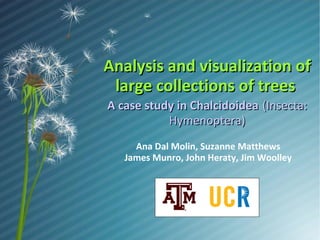Whs121
- 1. Analysis and visualization of large collections of trees A case study in Chalcidoidea (Insecta: Hymenoptera) Ana Dal Molin, Suzanne Matthews James Munro, John Heraty, Jim Woolley
- 2. The tree space ’ü¼ ’ü¼ ’ü¼ The number of possible trees is given Criteria exist to determine which ones are better hypotheses Heuristics
- 3. The tree space ’ü¼ ’ü¼ ’ü¼ The number of possible trees is given Criteria exist to determine which ones are better hypotheses Heuristics
- 4. Case study ’ü¼ ’ü¼ ’ü¼ 525 terminals 2992 characters, rDNA (18S and 28S D2-D5) sequences Structural alignment + MAFFT alignment of the RAA's (EINSI)
- 5. Secondary structure is characterized by stems (paired bases) and loops (unpaired bases): alignment
- 6. Case study: symptoms ’ü¼ Inconsistencies across repeated analyses ’ü¼ Spurious relationships ’ü¼ Why?
- 7. ŌĆ£low supportŌĆØ ŌĆ£results highly sensitive to the method usedŌĆØ recognized tribes and subfamilies group, but not in a plausible place
- 8. Problems 1. Growing data sets lead to growing number of trees, sometimes too large to be compared by eye 2. Dozens of thousands of trees with hundreds of terminals = really large files ’ü¼ Can I even load them? 3. Inconsistencies and polytomies in consensus trees: ’ü¼ Do we have rogue taxa? ’ü¼ Has the search run enough? ’ü¼ Do we have enough signal?
- 9. Methods ’ü¼ ’ü¼ TNT, 5 seeds, unweighted parsimony 5 different seeds resulted in 30,000 trees, 20061 steps, CI=0.165, RI=0.62 ’ü¼ Portability: TreeZip ’ü¼ Set operations: TreeZip ’ü¼ Comparison via matrices of RF distances: MrsRF ŌłÆ Heatmaps of the distance matrices plotted using R
- 10. 1. Portability and set operations File size comparison ŌĆó a print screen of file structure ŌĆó [hashing?] ŌĆó Reference for details
- 11. Set Operations ŌĆó All trees were unique in every set but ŌĆó Union = 32,300 (unique) trees, not 150,000 ŌĆó Intersection = 28,422 trees ŌĆó ConsensusŌĆ”.
- 12. 2. Comparisons: MrsRF ’ü¼ 5x5 heatmap
- 13. Large heatmap
- 14. Distance between consensus trees = 0
- 15. Color strict consensus tree
- 16. More Information
- 17. Acknowledgements









![1. Portability and set operations
File size comparison
ŌĆó a print screen of file
structure
ŌĆó [hashing?]
ŌĆó Reference for details](https://image.slidesharecdn.com/whs12-131119140604-phpapp01/85/Whs121-10-320.jpg)






